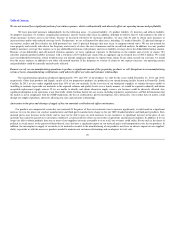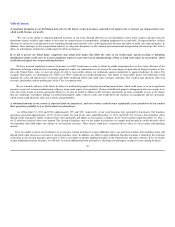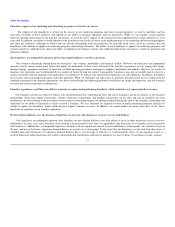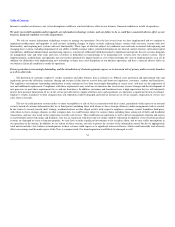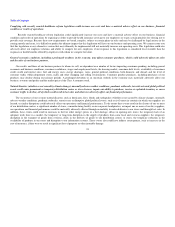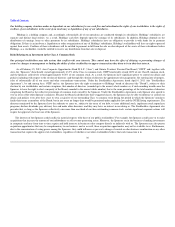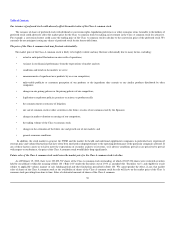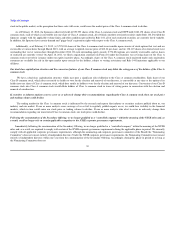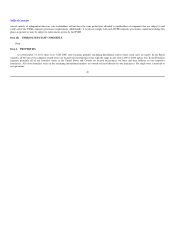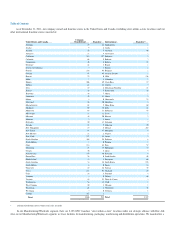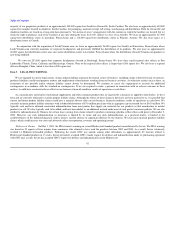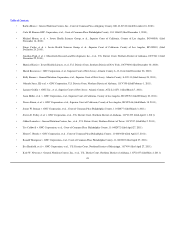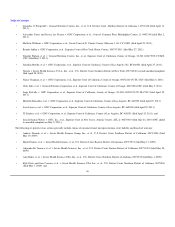GNC 2012 Annual Report Download - page 41
Download and view the complete annual report
Please find page 41 of the 2012 GNC annual report below. You can navigate through the pages in the report by either clicking on the pages listed below, or by using the keyword search tool below to find specific information within the annual report.
Table of Contents
stock in the public market, or the perception that those sales will occur, could cause the market price of the Class A common stock to decline.
As of February 15, 2012, the Sponsors collectively held 44,953,993 shares of the Class A common stock and OTPP held 2,060,178 shares of our Class B
common stock, each of which is convertible into one share of Class A common stock, all of which constitute restricted securities under Rule 144. Provided the
Sponsors comply with the applicable volume limits and other conditions prescribed in Rule 144, all of such restricted securities are currently freely tradable.
In addition, the Sponsors have certain demand and "piggy-back" registration rights with respect to the Class A common stock.
Additionally, as of February 15, 2012, (i) 5,795,943 shares of the Class A common stock were issuable upon exercise of stock options that vest and are
exercisable at various dates through March 2021, with an average weighted exercise price of $12.36 per share, and (ii) 138,119 shares of restricted stock were
outstanding that vest at various dates through December 2016. Of such outstanding equity awards, 2,774,824 options are currently exercisable, and no shares
of restricted are currently vested. On April 18, 2011, we filed a registration statement on Form S-8 under the Securities Act covering shares of the Class A
common stock reserved for issuance under our equity incentive plans. Accordingly, shares of the Class A common stock registered under such registration
statement are available for sale in the open market upon exercise by the holders, subject to vesting restrictions and Rule 144 limitations applicable to our
affiliates.
Our dual-class capitalization structure and the conversion features of our Class B common stock may dilute the voting power of the holders of the Class A
common stock.
We have a dual-class capitalization structure, which may pose a significant risk of dilution to the Class A common stockholders. Each share of our
Class B common stock, which does not entitle its holder to vote for the election and removal of our directors, is convertible at any time at the option of its
holder into one share of Class A common stock, which does entitle its holder to vote for the election and removal of our directors. Conversion of our Class B
common stock into Class A common stock would dilute holders of Class A common stock in terms of voting power in connection with the election and
removal of our directors.
If securities or industry analysts cease to cover us or adversely change their recommendations regarding the Class A common stock, then our stock price
and trading volume could decline.
The trading market for the Class A common stock is influenced by the research and reports that industry or securities analysts publish about us, our
industry and our market. If one or more analysts cease coverage of us or fail to regularly publish reports on us, we could lose visibility in the financial
markets, which in turn could cause our stock price or trading volume to decline. If one or more analysts who elect to cover us adversely change their
recommendation regarding our unrestricted Class A common stock, our stock price could decline.
Following the consummation of the Secondary Offering, we no longer qualified as a "controlled company" within the meaning of the NYSE rules and, as
a result, could no longer rely on certain applicable exemptions to the NYSE corporate governance requirements.
Immediately following the consummation of the Secondary Offering, we no longer qualified as a "controlled company" within the meaning of the NYSE
rules and, as a result, are required to comply with certain of the NYSE corporate governance requirements during the applicable phase-in period. We currently
comply with all applicable corporate governance requirements, although the nominating and corporate governance committee of the Board (the "Nominating
Committee") does not consist entirely of independent directors. Under the NYSE corporate governance requirements, the Nominating Committee must consist
entirely of independent directors within one year from the consummation of the Secondary Offering. Accordingly, during this phase-in period or so long as
the Nominating Committee does not
39


